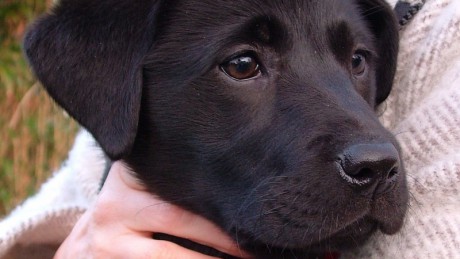
Fritz has been an enthusiastic chewer since he arrived in the Emily’s household as a puppy. Whenever there was anything within reach that he could pick up in his mouth, he chewed it. Emily had hoped that this was just a puppy habit, but as he’s grown older, the chewing behaviour has shown no sign of stopping.
It’s nothing to do with his appetite: he just enjoys picking things up in his mouth and chewing them. There’s an added twist to his behaviour: he doesn’t like having anything taken away from him. If somebody tries, he’ll either growl to try to scare the person off, or he’ll do something even more radical: swallow the object whole.
Emily’s family have been trying to deal with this problem, teaching him a “leave it” command so that he’ll voluntarily drop objects.
This type of guarding behaviour can be dangerous to humans, because people – especially children – can get bitten trying to take something away from a dog. It’s possible to train dogs not to guard objects by persuading them to “trade up” for something better such as a food treat or another toy. The idea is to give a dog an object that they’re not particularly keen on, and say, “take it.” You then say “give it” and take the object back at the same time as rewarding the dog with a treat. You do this repeatedly, then the next day, move to a more desirable object and do it again. Over weeks, you can gradually move to the stage where a dog willingly gives up objects on command. This process needs to be done carefully, under the guidance of a good dog trainer, to make sure that nobody gets hurt by a dog being asked to give up objects when he hasn’t yet reached that stage of willingness.
Fritz’s obsession with chewing objects caused another dangerous situation a few weeks ago, and this time it was Fritz himself who was at risk. He managed to open some cupboards beside his sleeping area, dragging out various objects which he proceeded to chew and swallow. Soon after, he became dull and depressed, and he started to vomit. He was brought him in to see me, and an x-ray confirmed their suspicion: he was suffering from an intestinal obstruction.
An emergency operation was needed to remove a cocktail of objects from his digestive tract: part of a wellington boot, the zip of a ski jacket and the edge of his bed. He made a good recovery from this major surgery, but it’s become even more urgent to solve his chewing problem. The next time, he might not survive the repeated surgery that would be needed.
Emily and her family have employed a behavioural advisor to help them sort out the problem as soon as possible. Fritz has plenty of safe objects to chew, such as toys designed for the purpose, and he’s been encouraged to choose these instead of household objects. Whenever he’s left alone, he’s given a hollow rubber “Kong” toy which was stuffed with food the night before, then kept in the deep freeze. As he chews the toy, he’s rewarded with food that gradually thaws out. This encourages him to continue to chew the safe toy rather than other objects in his immediate environment.
Fritz is still young. The steps that have been taken will help to deal with his problems, and as he grows older, he should lose some of the youthful exuberance that makes him so excited about chewing everything. Emily doesn’t want him to change too much though: she loves him just the way he is.
Tips
- It’s normal for puppies to enjoy chewing
- Safe dog chews should be provided to avoid problems like Fritz has experienced
- If a dog “guards” his toys, careful steps should be taken to train him out of the habit




Please note that I am unable to answer veterinary questions in comments. If you have questions or concerns about your pet's health it is always better to contact your vet.